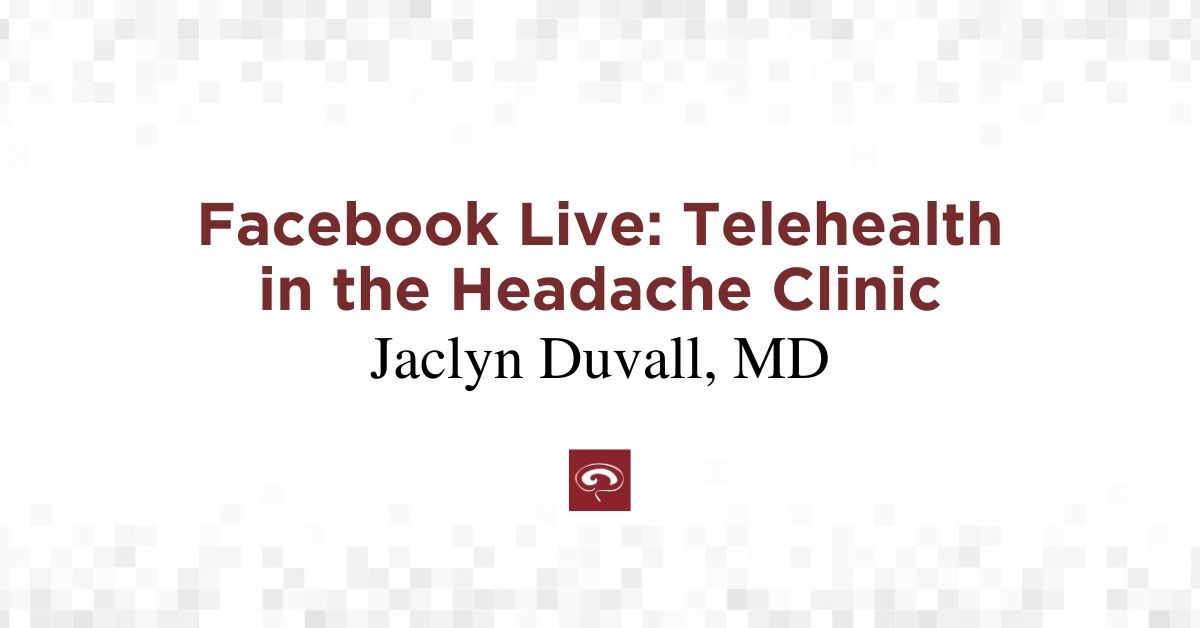
Implementing Telehealth in the Headache Clinic with Jaclyn Duvall, MD
AHS Member Jaclyn Duvall, MD, explains how to implement telemedicine in your headache clinic
When the COVID-19 pandemic started, Jaclyn Duvall, MD, a headache specialist in Tulsa, OK, knew that her clinic would need to make immediate changes to reduce the risk of viral transmission while providing headache care for patients. During her Facebook Live for the American Headache Society, Dr. Duvall explained how to use telemedicine in the headache clinic and provides resources that may help providers transition to telemedicine.

Tips for Implementing Telemedicine in the Headache Clinic
- Choose a Virtual Platform
Some HIPPA compliant examples include: Doximity, Doxy.me, Zoom for Healthcare and Webex. Other platforms like FaceTime might be more accessible but are not HIPPA compliant and patients should be aware of that risk.If your practice contracts with a HIPAA compliant vendor, you must also get a Business Associate Agreement (BAA). - Provide Instructions to Patients
Dr. Duvall suggests having staff call patients in advance to explain the process and complete consent forms and then sending portal messages with written instructions for the telemedicine visit. Consent for telemedicine should include participation in the telehealth visit including any limitations of this technology, potential for HIPPA violations (if you use a non-compliant platform) and agreement to financial responsibility. - Set up the Appointment
Preparation is key. From setting up the display email address and initiating the call to starting with a standard script, preparation from both you and the patient is essential for a successful appointment. Patients should be in a quiet location, free from distraction prior to their scheduled appointment time. It is ideal that they have an updated medication list, paper and pen to write instructions, and a list of things they want to discuss. - Telemedicine Billing
AAN recently released a helpful guide for telemedicine that includes a link for tracking many private payer’s changes. If the patient is using medicare, the medicare website has a telemedicine health care provider fact sheet. Otherwise, commercial insurer rules differ from company to company and state to state. It is essential that patients investigate if their commercial insurance covers telemedicine visits. For coding telehealth visits (new and follow-up appointments via video), choose your typical level of service: OUTPATIENT EM (99201-99205) & PROLONGED SERVICES (99354-99357). Then, change place of service to 02 (telemedicine) and modifier 95 (synchronous telemedicine service); in some cases a ‘95’ modifier may not be built into your EMR—additional modifiers include GT (telemedicine) or CR (catastrophe relief). - Follow Proper Documentation Protocol
Dr. Duvall explains how to document virtual examinations. She uses two patient identifiers and confirms the patient’s location during this visit, noting for the record that this visit occurred during the Coronavirus (COVID-19) Public Health Emergency. She also confirms she obtained verbal and written consent from the patient to perform the clinical encounter utilizing video. In addition, she prepared the patient by answering any questions they have about the telehealth interaction.- Tell patients you are not recording their sessions and you are protecting their personal health records.
- Tell the patient you will evaluate the patient and recommend diagnostics and treatments based on assessment.
- Explain to the patient that the team will provide follow up care in person if/when the patient needs it.
Telemedicine is critical to protecting patients and providers while still caring for our patients with migraine and other headache disorders. Please follow the American Headache Society’s Facebook page to be alerted to our next Facebook Live Event.
The American Headache Society is committed to providing support for headache clinics and practitioners during the COVID-19 pandemic. For more on the latest headache information and studies, visit the AHS News page.


